The type genus Tamarix, also called the comb, or tamarisk, belonging to the Tamarisk family, is represented by shrubs and small trees. This genus unites more than 75 species. Such a plant is also called bead, gidovilnik, jengil, god's tree, comb and Astrakhan lilac. The scientific name tamarix comes from the toponym of the Tama-riz river, which is located in the Pyrenees, at the moment it is called Timbra. In nature, tamarix can be found in Asia, Africa and in the southern part of Europe, while it prefers to grow in deserts and semi-deserts, in dune sands, and also on salt licks and salt marshes. For example, in the tugai forests of Central Asia, there are 15 species of such a plant; in the mountains of Central Asia, it is found at an altitude of about 2000 meters above sea level, while in the Caucasus tamarix rises to a height of no more than 600 meters.
The tamarisk shrub is cultivated by gardeners as an ornamental and sand-fixing plant.
Content
Features of the tamarix shrub
The graceful tamarisk shrub can be deciduous or evergreen. In addition to shrubs, trees are often found that grow bush-like, they have a height of 1.5-12 meters, and their trunk is not thicker than half a meter. The crown consists of rod-shaped stems, on which there is a huge number of alternately located small leaf plates similar to scales, their color can be emerald, greenish-blue or dark green. Large panicle or racemose inflorescences consist of small white or pink flowers. Before flowering, when the bush is strewn with many unopened buds, it may seem as if it was decorated with beads. This plant is an excellent honey plant, therefore, during the flowering period, it attracts bees to the garden. The fruit is a pentahedral-pyramidal box, which is polyspermous, inside it has small seeds.
Tamarisk is a very tenacious plant that is highly resistant to drought. This shrub can be grown even in a large city, because it is resistant to gas pollution. Growing such a plant is not troublesome and very pleasant.
Planting tamarix in open ground
What time to plant
It is recommended to plant tamarix seedlings in open soil in the autumn during leaf fall, but it is better to do this at the very beginning of spring. The soil for such a shrub needs a well-drained one, while its composition can be of any kind. It can be grown even in heavy clay soil, but only in this case humus and peat must be added to the soil during planting. You can grow tamarisk in the shade, but it is better to choose a well-lit area for planting it.
The choice of a site for planting such a shrub must be done very carefully, because because of the long thin roots that are easy to damage, it suffers a rather painful transplant.
How to plant correctly
The size of the landing pit should be 0.6x0.6x0.6 meters. At the bottom of the finished pit, you need to make a good drainage layer, the thickness of which should be about 20 centimeters, for this you can use broken brick, crushed stone, expanded clay or pebbles. A mixture consisting of humus and wood ash must be laid on top of the drainage. Then the foundation pit should be covered by 2/3 of soil mixture, which contains sand (1 part), fertile soil (2 parts) and peat (1 part).
Before planting, trim the stems of the seedling, while the remaining segments should not exceed 30-50 mm in length. Then the plant must be placed in a pit, which should be covered with soil mixture (the composition is described above), but only after the roots of the seedling are carefully spread. Tamp the surface of the soil around the planted plant, and then water it well. When planting, it should be borne in mind that after the seedling is watered, its root collar should be at the level of the surface of the site.


Watch this video on YouTube
Tamarisk garden care
A tamarix seedling planted in open soil needs protection from direct sunlight and systematic watering during the first 15–20 days. After the leaves appear on the plant, they stop protecting it from the sun's rays, and also reduce the amount of watering. In order to prevent water from evaporating from the soil so quickly, its surface must be covered with a layer of mulch, for this you can use any organic material. Adult shrubs need watering only during a long dry period, but if it rains regularly in the summer, then there is no need to water the tamarix at all. After the rain has passed or watering has been carried out, the surface of the trunk circle should be slightly loosened, while pulling out all the weeds.
Top dressing of the shrub is done in the spring, as soon as the growing season begins, for this they use organic fertilizer. In the summer, it should be sprayed over the foliage with a solution of phosphorus and potassium fertilizers.
Tamarix is characterized by high winter hardiness, therefore it can be cultivated in regions with not very warm climates. So, in the Urals and in the Moscow region, this plant is widespread today. This shrub, without shelter, is able to withstand temperatures down to minus 28 degrees. If the winters are very cold, then such a shrub simply needs shelter. To do this, the root zone should be covered with a thick layer of sawdust or covered with spruce branches, the trunk should be wrapped with a dense cloth or polymer film.
Pruning tamarix
Tamarix needs shaping scraps, which he transfers easily enough. The best time to trim the crown is early spring, and you need to catch it before the buds swell. Old branches that have short growths need to be cut into a ring, after only 4 weeks they will give young shoots, and the shrub will again become lush and beautiful. Such a plant needs rejuvenating pruning. They are made on a strong branch, which is placed as close to the base of the bush as possible.Remember that the growth of the stems should not diminish, as this will reduce the number and length of the inflorescences. With the beginning of the growing season, branches and stems damaged by frost can be identified, which will need to be cut to healthy wood.
You can also prune the shrub at the end of flowering. In order for the crown to remain effective and well-groomed, it is necessary to cut off excessively elongated stems, as well as inflorescences that have begun to fade. When pruning the shrub, try to make it more stable, otherwise its branches will need to be tied to the supports.
In tamarisk, the crown thickens very quickly, in this regard, its thinning should be carried out systematically, cutting out part of the branches for this.
Diseases and pests
This shrub is highly resistant to pests. They can settle on it only if any of the neighboring plants is infected. To get rid of pests, it will be enough to spray the plant with an insecticide solution only once.
During the rainy season, tamarix can easily contract a fungal disease. Infected stems and branches should be cut and destroyed, and the bush itself and the soil around it should be sprayed with a fungicide solution.
Reproduction of tamarix in the garden
It is quite possible to grow tamarix from seeds, however, experienced gardeners do not advise spending their time on this, since cuttings are a more reliable and faster way of propagating such a plant.
You can propagate the shrub by cuttings at the beginning of the spring. To do this, it is necessary to prepare semi-lignified cuttings 10 millimeters thick and 7-10 centimeters long. The lower cut should be treated with a solution of an agent that stimulates the growth of roots, then they should be planted at an angle in a container filled with a light soil mixture consisting of sand and garden soil (1: 1). It is imperative to put a dome on the top of the box, which must be transparent. Instead, you can cover each stalk with a glass jar on top. After the cuttings take root, young leaves will begin to grow. These cuttings are planted in open soil in May, and do not forget that they need a mandatory shelter for the winter. With the onset of the next spring period, the plants that have survived the winter can be transplanted to a permanent place.
You can resort to another method of rooting; for this, the cuttings are placed in a container filled with water. When the roots appear on the cuttings, they will need to be planted in the garden and covered with glass jars.
When propagating tamarisk by the generative (seed) method, remember that its seeds retain good germination for a short time, and when growing a shrub in mid-latitudes, they rarely ripen. There is no need to stratify seeds before sowing. They are simply distributed evenly over the surface of the soil mixture, without deepening or sprinkling with earth. Then the container must be placed on a pallet that is filled with water. Strengthened and grown plants must be planted in school for growing. Seedlings need good shelter for the winter. After 1 or 2 years, the plant can be planted in a permanent place.
Types and varieties of tamarix with photos and names
There are more than 70 species of tamarix in nature. However, most often those of them are cultivated that have a high frost resistance.
Tamarix tetrandra (Tamarix tetrandra)
In nature, this species is found in Greece, Crimea, Asia Minor, as well as in the southeast of the European part of Russia. This shrub is relatively large and reaches a height of 5-10 meters. Arcuate curved branches are painted red-brown. Green-emerald leaf plates have an ovate-lanceolate or lanceolate shape, they taper towards the base, and at their top there is a beak-shaped sharpening. On the lateral shoots there are racemose inflorescences, consisting of flowers, painted in various shades from pale pink to white. The plant blooms in April or May.This shrub is drought tolerant and durable (it can live for about 75 years).
Loose tamarix (Tamarix laxa)
Under natural conditions, such a plant is found in northwestern China, northern Iran, Mongolia, Afghanistan and in the lower Volga. This species is represented by a large branched shrub or a medium-sized tree, its height is about 5 meters. The bare, spreading branches are colored gray or green. Directly spaced leaf plates, oval-rhombic or ovoid, taper towards the base and sharpen towards the apex. The apical panicles are formed by lush racemose inflorescences consisting of pink flowers. This plant blooms for about 8 weeks. This species is distinguished by its drought and frost resistance, it is not picky about the soil and normally tolerates its salinity.
Tamarix graceful (Tamarix gracilis)
Under natural conditions, such a tamarisk is found in China, Ukraine, Kazakhstan, Siberia, in the west of Mongolia and in the south of the European part of Russia. The shrub height does not exceed 4 meters. On the surface of thick, concatenated branches, there are pale fawn specks of cork in the leaf axils and along the shoot. The color of the bark is greenish gray or chestnut brown. Pointed leaf plates on green shoots are tiled. On one-year-old branches, leaf plates of a larger size grow, and they have a lanceolate shape and a fawn color. Simple spring racemose inflorescences are about 50 mm long and consist of deep pink flowers. Summer flower clusters are part of large paniculate inflorescences, and they reach 70 mm in length. This type is frost-resistant and beautifully flowering, it is often used by landscape designers.
Branched tamarix (Tamarix ramosissima), or five-grained tamarix (Tamarix pentandra)
In the wild, such a plant can be found in Iran, Mongolia, Moldova, China, Central Asia, Ukraine and the Balkans. It prefers to grow on river banks, pebble banks and on the terraces of river valleys. The height of such an upright shrub is about 2 meters. Thin branches are light gray or pale green, and annual shoots are pale red. Narrow awl-shaped leaf plates have curved tips. Dense, compound racemose inflorescences reach 50 mm in length, they consist of pink flowers. Flowering occurs in June – September. Such a shrub is not picky about the composition of the soil, it quickly adapts to the conditions of the city, after freezing it is easily restored, but it must be covered for the winter. Popular varieties:
- Pink Cascade... This variety blooms very luxuriantly.
- Rubra... The color of the flowers is red-violet.
- Summare Glow... The color of the flowers is rich crimson.
Tamarisk in landscape design
Tamarisk is used in landscaping for group compositions and trimmed hedges. This plant is also used as a tapeworm, for example, as a flowering "fountain" in the center of a green lawn. Not very tall trees and shrubs of this genus are recommended to be combined with conifers, namely: thuja, juniper and dwarf spruce. Also, this plant is in harmony with lilac, barberry and jasmine.
Some evergreen tamarisk species are cultivated at home. Also, tamarix is grown on saline soils, in forest plantations, in deserts and semi-deserts, and is also used to consolidate moving sands and slipping banks.


Watch this video on YouTube

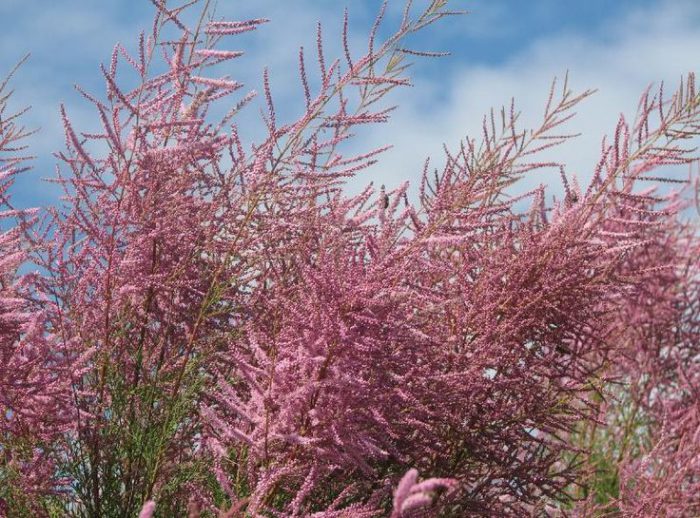

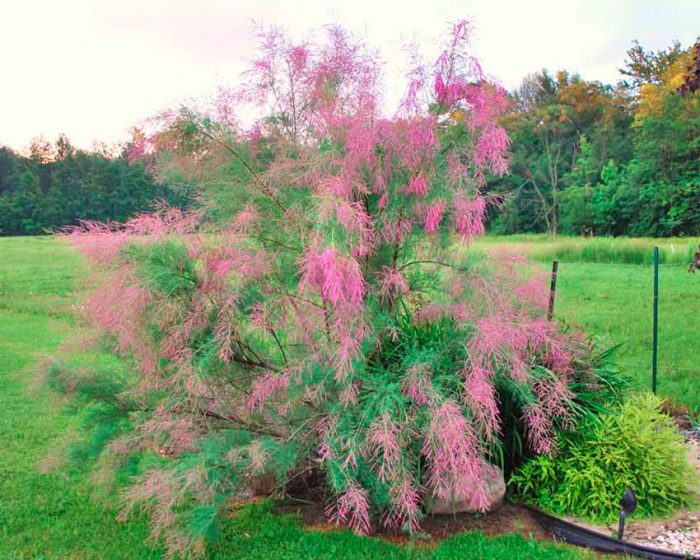
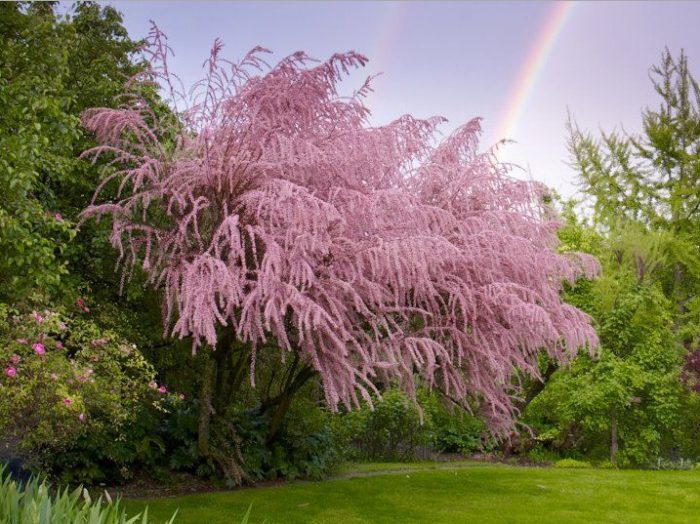

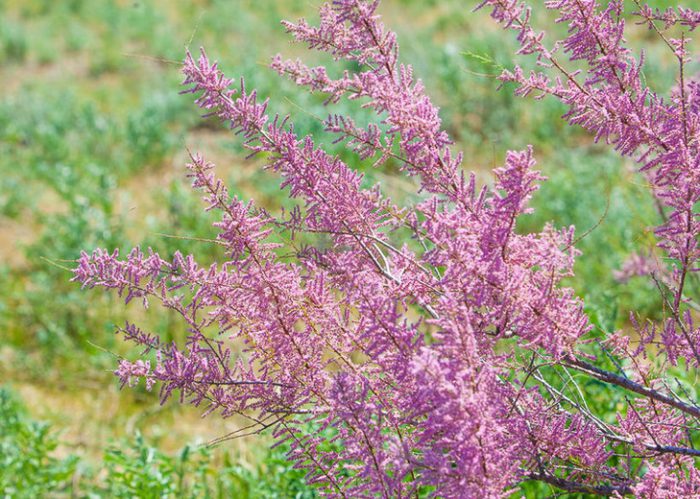
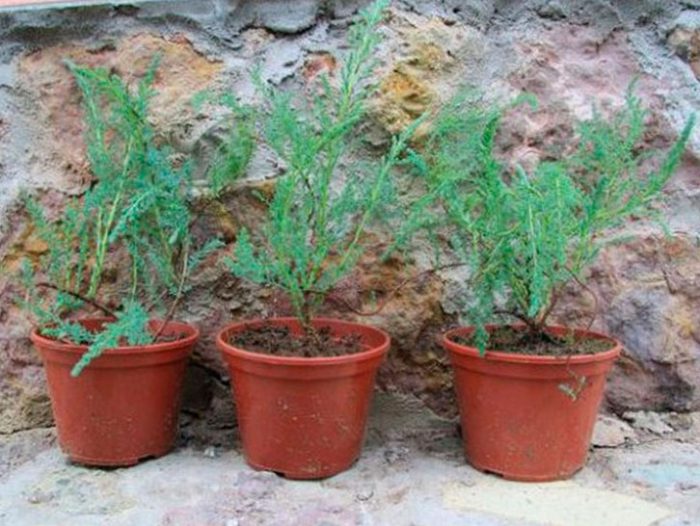
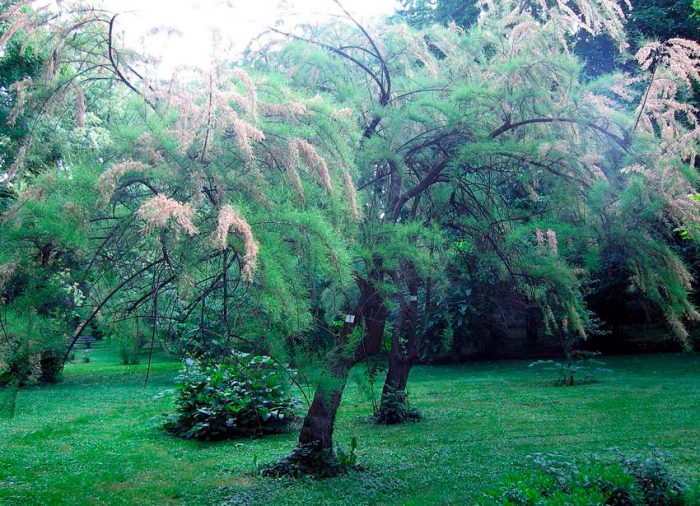
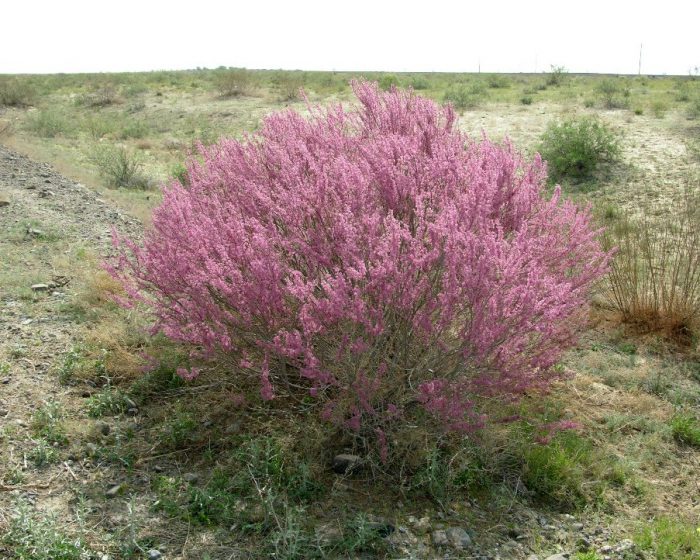
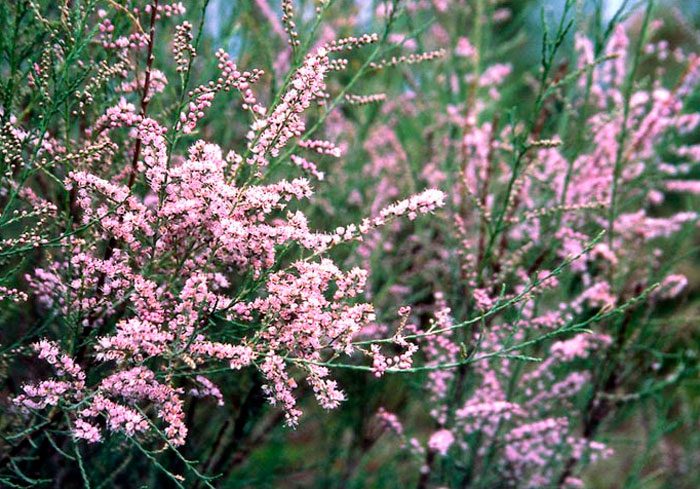
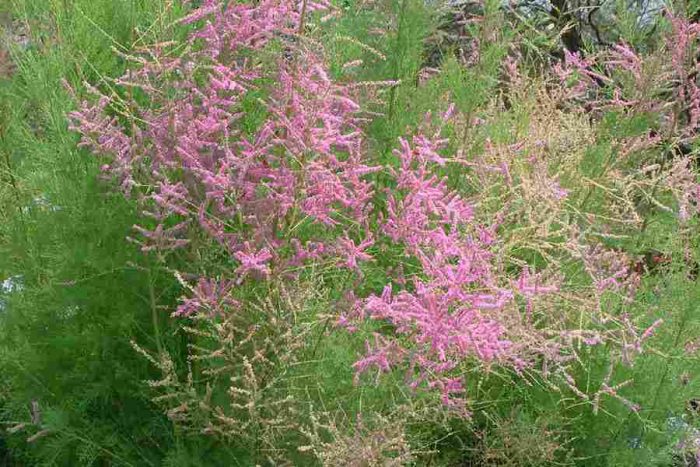
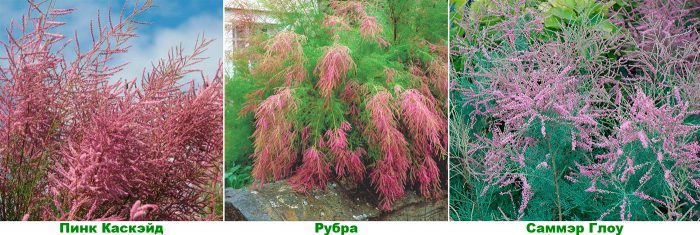
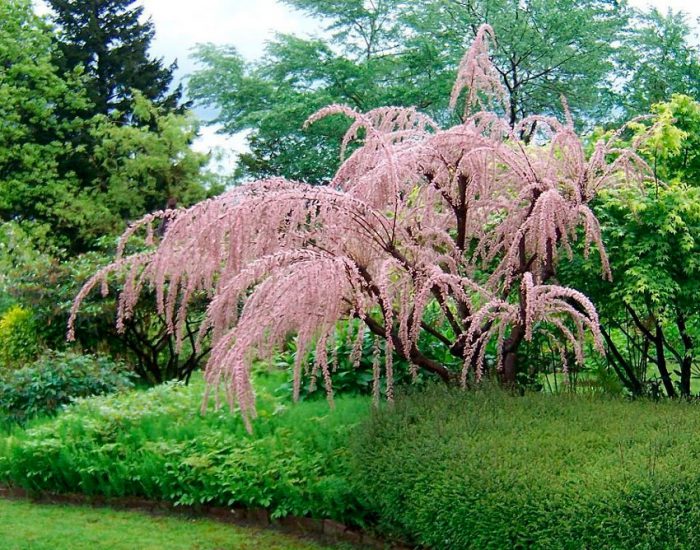










In the summer, cutting off lignified branches, believing that they were completely dry, I laid them in the soil, left both ends outside (above the soil), watered, watered and forgot ...
How pleasantly surprised I was, after a couple of months, when I saw a lot of green twigs, 10-15 cm, growing above the soil, and the remaining in the pot bloomed!
Thank!